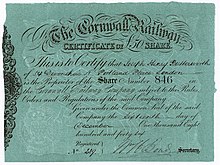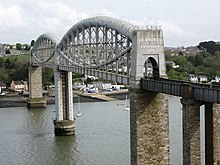Cornwall Railway
The Cornwall Railway was a British railway company based in Cornwall , England.
The company was founded on August 3, 1846. The largest owners of the £ 1,600,000 Cornwall Railway were the Great Western Railway (£ 75,000), the Bristol and Exter Railway (£ 112,000) and the South Devon Railway (£ 150,000).
Isambard Kingdom Brunel was responsible for planning the route . The line from Plymouth to Truro , built in the broad gauge of 2140 mm, was opened on May 2, 1859. At the same time, the Royal Albert Bridge in Saltash was opened. This completed the continuous rail link from London to Penzance . The extension to Falmouth was put into operation on August 24, 1863. The line was also leased by the other railway companies for 1000 years. The company was in the red, however, and in the summer of 1875 the National Provincial Bank temporarily took over administration. After the other shareholders were taken over by the Great Western Railway, it was the sole operator from January 1, 1877. As a result, there were various differences between the GWR and the Cornwall Railway. Among other things, the cost of replacing the expensive wooden bridges was disputed. The Cornwall Railway was finally taken over on June 24, 1889. The changeover to standard gauge took place on May 21, 1892.
In order to keep the costs for the locomotives low, these were provided by Evans & Company. In 1867 the Southern Devon Railway took over the contract and provided the locomotives for the Cornwall Railway. Locomotives of the Eagle Class , Dido Class and Buffalo Class as well as other individual vehicles were used.
The passenger and freight cars were purchased and serviced in the Lostwithiel workshops. In 1889 there were 421 vehicles in stock.
literature
- Christopher Awdry: Encyclopaedia of British Railway Companies . Stephens, Wellingborough 1990, ISBN 1-85260-049-7 .

